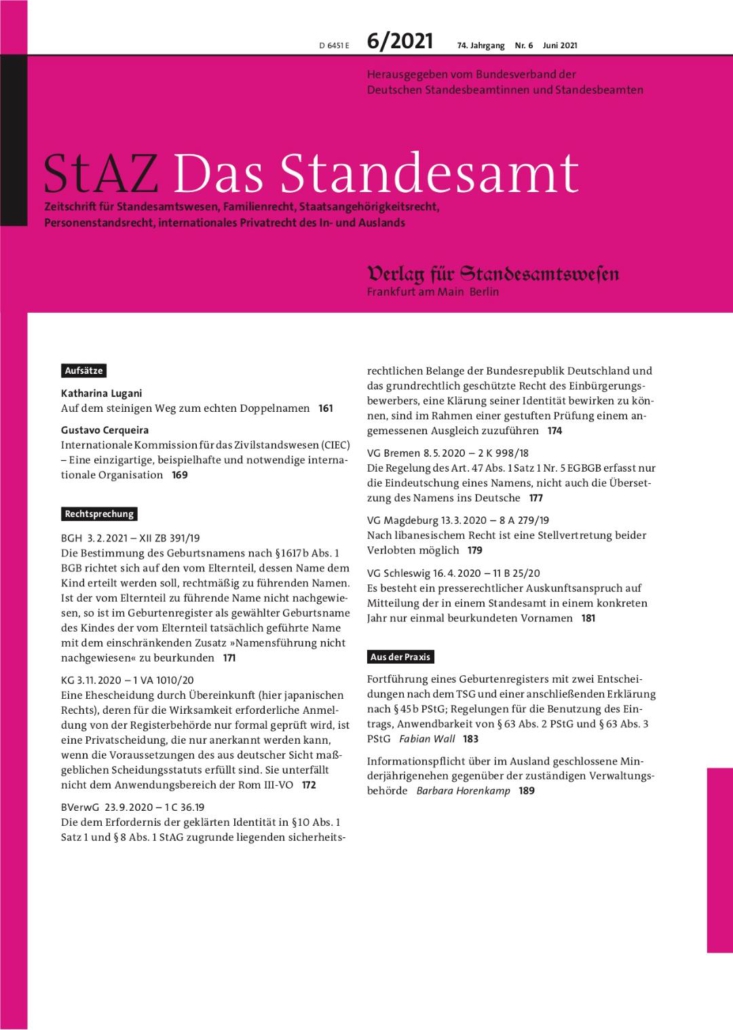Praxis des Internationalen Privat- und Verfahrensrechts (IPRax) 4/2021: Abstracts
The latest issue of the „Praxis des Internationalen Privat- und Verfahrensrechts (IPRax)“ features the following articles:
O. Remien: The European Succession Regulation and the many questions of the European court practice – five years after entry into force
After five years of application of the European Succession Regulation it is time to have a look at European court practice: The general connecting factor of habitual residence has somehow been addressed by the European Court of Justice (ECJ) in E.E., but especially national court practice shows many interesting cases of the necessary overall assessment. Choice of law by the testator is particularly important and a notary should point not only at the present situation, but also at possible developments in the future. Estate planning has become more interesting. The legacy per vindicationem (Vindikationslegat, i.e. with in rem effect) recognized in Kubicka poses specific problems. The position of the surviving spouse under § 1371 BGB in German law has become a highly debated subject and here the aspect of free movement of persons is highlighted. The European Succession Certificate also raises many questions, among them the applicability of the competence rules in case of national notarial succession certificates or court certificates, cases Oberle, WB and E.E.. The article pleads for an equilibrated multilateral approach. Donation mortis causa will have to be dealt with by the ECJ soon. Five years of application of the Succession Regulation – and many questions are open.
P. Hay: Product Liability: Specific Jurisdiction over Out-of-State Defendants in the United States
“Stream of commerce” jurisdiction in American law describes the exercise of jurisdiction in product liability cases over an out-of-state enterprise when a product produced and first sold by it in another American state or a foreign country reached the forum state and caused injury there. The enterprise cannot be reached under modern American rules applicable to “general” (claim unrelated) jurisdiction. Can it be reached by exercise of “specific” (claim related) jurisdiction even though it did not itself introduce the product into the forum state? This is an important question for interstate American as well as for foreign companies engaged in international commerce. The applicable federal constitutional limits on the exercise of such “stream of commerce” jurisdiction have long been nuanced and uncertain. It was often assumed that the claim must have “arisen out of” the defendant’s forum contacts: what did that mean? The long-awaited U.S. Supreme Court decision in March 2021 in Ford vs. Montana now permits the exercise of specific jurisdiction when the claim arises out of or is (sufficiently) “related” to the defendant’s in-state contacts and activities. This comment raises the question whether the decision reduces or in effect continues the previous uncertainty.
W. Wurmnest: International Jurisdiction in Abuse of Dominance Cases
The CJEU (Grand Chamber) has issued a landmark ruling on the borderline between contract and tort disputes under Article 7(1) and (2) of the Brussels I-bis Regulation. Wikingerhof concerned a claim against a dominant firm for violation of Art. 102 TFEU and/or national competition law rules. This article analyses the scope of the ruling and its impact on actions brought against dominant firms for violation of European and/or national competition law and also touches upon the salient question as to what extent such disputes are covered by choice of court agreements.
C.F. Nordmeier: The waiver of succession according to Art. 13 Regulation (EU) 650/2012 and § 31 IntErbRVG in cases with reference to third countries
According to Art. 13 Regulation (EU) 650/2012, a waiver of succession can be declared before the courts of the state in which the declarant has his habitual residence. The present article discusses a decision of the Cologne Higher Regional Court on the acceptance of such a declaration. The decision also deals with questions of German procedural law. The article shows that – mainly due to the wording and history of origin – Art. 13 Regulation (EU) 650/2012 presupposes the jurisdiction of a member state bound to the Regulation (EU) 650/2012 to rule on the succession as a whole. Details for establishing such a jurisdiction are examined. According to German procedural law, the reception of a waiver of succession is an estate matter. If Section 31 of the IntErbRVG is applicable, a rejection of the acceptance demands a judicial decree which is subject to appeal.
P. Mankowski: The location of global certificates – New world greets old world
New kinds of assets and modern developments in contracting and technology pose new challenges concerning the methods how to locate assets. In many instances, the rules challenged are old or rooted in traditional thinking. Section 23 of the German Code of Civil Procedure (ZPO) is a good example for such confrontation. For instance, locating global certificates requires quite some reconsideration. Could arguments derived from modern legislation like the Hague Intermediated Securities Convention, Art. 2 pt. (9) EIR 2015 or § 17a DepotG offer a helping hand in interpreting such older rules?
S. Zwirlein-Forschner: All in One Star Limited – Registration of a UK Company in Germany after the End of the Brexit Transition Period
Since 1 January 2021, Brexit has been fully effective as the transition period for the UK has ended. In a recent decision, the Federal Court of Justice (BGH) has taken this into account in a referral procedure to the Court of Justice of the European Union (CJEU). The decision raises interesting questions on the demarcation between register law and company law, on conflict of laws and on the interpretation of norms implementing EU law. This article comments on these questions.
K. Sendlmeier: Informal Binding of Third Parties – Relativising the Voluntary Nature of International Commercial Arbitration?
The two decisions from the US and Switzerland deal with the formless binding of third parties to arbitration agreements that have been formally concluded between other parties. They thus address one of the most controversial issues in international commercial arbitration. Both courts interpret what is arguably the most important international agreement on commercial arbitration, the New York Convention on the Recognition and Enforcement of Foreign Arbitral Awards of 1958. The Supreme Court has ruled that the Convention does not preclude non-signatories from being bound by arbitration based on equitable estoppel in US arbitration law. In the Swiss decision, the binding nature of a non-signatory is based on its interference in the performance of the main contract of other parties. According to the established case law of the Swiss Federal Tribunal, this binding approach does not conflict with the New York Convention either.
K. Bälz: Can a State Company be held liable for State Debt? Piercing of the Corporate Veil vs. attribution pursuant to Public International Law – Cour d’appel de Paris of 5 September 2019, No. 18/17592
The question of whether the creditor of a foreign state can enforce against the assets of public authorities and state enterprises of that state is of significant practical importance, particularly in view of the increasing number of investment arbitrations. In a decision of 5 September 2019, the Paris Court of Appeal has confirmed that a creditor of the Libyan State can enforce an arbitral award against the assets of the Libyan Investment Authority (LIA), arguing that – although the LIA enjoys separate legal personality under Libyan law – it was in fact an organ (émanation) of the Libyan State, that was functionally integrated into the state apparatus without clearly separated assets of its own. This approach is based on public international law concepts of state liability and diverges from corporate law principles, according to which a shareholder cannot generally be held liable for the corporation’s debts.
O.L. Knöfel: Liability of Officials for Sovereign Acts (acta iure imperii) as a Challenge for EU and Austrian Private International Law
The article reviews a decision of the Supreme Court of the Republic of Austria (Case 1 Ob 33/19p). The Court held that a civil action for compensation brought in Austria, by the victim of a downhill skiing accident, against a German school teacher on account of alleged negligence during a reconnaissance ride down an Austrian ski slope, does not constitute a “civil and commercial matter” under the Rome II Regulation, as it involves an actum iure imperii (Art. 1 cl. 1 Rome II Regulation). As a consequence, the Court applied German Law, relying on an alleged customary conflicts rule (lex officii principle), according to which indemnity claims against officials who act on behalf of the State are inevitably and invariably governed by the law of the liable State. Finally, the Court held that an action brought directly against a foreign official in Austria is not barred by sec. 9 cl. 5 of the Austrian Act of State Liability (Amtshaftungsgesetz). The Court’s decision is clearly wrong as being at variance with many well-established principles of the conflict of laws in general and of cross-border State liability in particular.
E. Piovesani: Italian Ex Lege Qualified Overriding Mandatory Provisions as a Response to the “COVID-19 Epidemiological Emergency”
Art. 88-bis Decree-Law 18/2020 (converted, with modifications, by Law 27/2020) is headed “Reimbursement of Travel and Accommodation Contracts and Package Travel”. This provision is only one of the several provisions adopted by the Italian legislator as a response to the so-called “COVID- 19 epidemiological emergency”. What makes Art. 88-bis Decree-Law 18/2020 “special” is that its para. 13 qualifies the provisions contained in the same article as overriding mandatory provisions.





